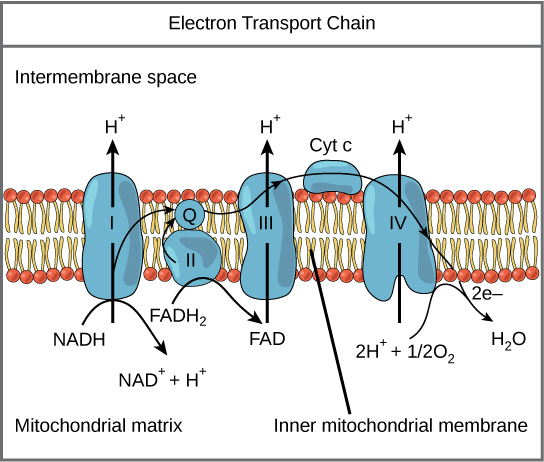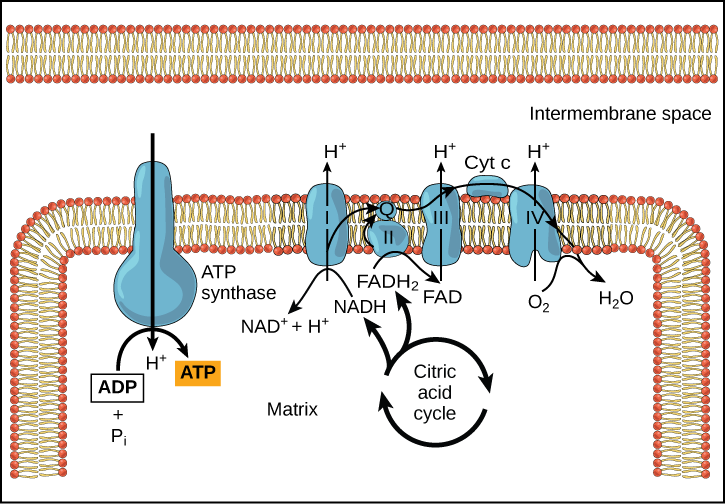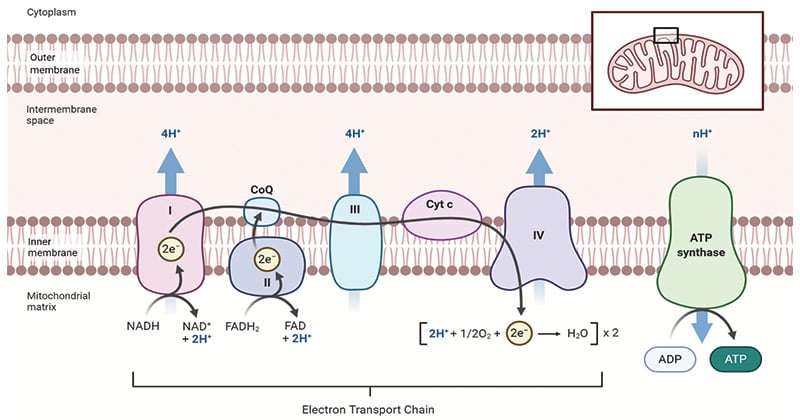Which of the Following Best Describes the Electron Transport Chain
Through a series of conformational changes ATP synthase generates ATP. The electron transport chain Figure 1.

Electron Transport Chain Biology For Majors I
Electron Transport Chain Definition.

. The electron transport chain involved in cellular respiration is located inon the _________________. The electron transport chain and the ATP synthase are effectively coupled. Which of the following best describes the electron transport.
Photosynthetic electron transport chain of the thylakoid membrane. The electron transport chain generates an electrochemical gradient that drives the production of ATP. B Hydrogen atoms are added to CO 2 to make an energy-rich compound.
The electron transport chain re-oxidizes reduced cofactors. Electrons pass from one carrier to another releasing a little energy at each step. Electron transport is defined as a series of redox reaction that is similar to the relay race.
A molecule is oxidized when it _____. Which phrase best describes the Electron Transport Chain ETC. If humans did not breathe in.
Electrons removed from glucose are shuttled by NADH to the top higher-energy end of the chain. Electrons are passed from one carrier to another releasing a little energy at each step. Electrons are passed from one carrier to another releasing a little energy at each step Electrons are pumped across a membrane by active transport Glucose is broken down to a three-carbon compound in preparation for the citric acid cycle Hydrogen atoms are added to CO2 to make an energy-rich.
ATP is used by the cell as the energy for metabolic processes for cellular functions. At the end of electron transport chain to accept electrons and form H 2 O. A Electrons are passed from.
The cellular respiration is a set of metabolic reaction and processes that take place in the cell of organ and convert nutrients include sugar amino acids fatty acids and most common oxidizing agent is molecular oxygen into ATP. The electron transport chain in the mitochondrion is the site of oxidative phosphorylation in eukaryotes. When electrons are passed from one component to another until the end of the chain the electrons reduce molecular oxygen thus.
C Electrons are pumped across a membrane by active transport. It is the stage that produces the most ATP molecules. The electron transport chain is the stepwise process of cellular respiration which produces water 34 ATP NAD and FAD.
In the process protons are pumped from the mitochondrial matrix to the intermembrane space and oxygen is reduced to form water. A Electrons are passed from one carrier to another releasing a little energy at each B Hydrogen atoms are added to CO2 to make an energy-rich compound. ATP synthase utilizes oxidized cofactors.
The electrons transfer. What is electron transport chain describe the steps. Which of the following best describes the electron transport chain of cellular respiration.
AElectrons are passed from one carrier to another releasing a little energy at each step. 65 Electrons are pumped across a membrane by active transport. Which one of the following best describes the electron transport chain.
The electron transport chain is a crucial step in oxidative phosphorylation in which electrons are transferred from electron carriers into the proteins of the electron transport chain which then deposit the electrons onto oxygen atoms and consequently transport protons across the mitochondrial membraneThis excess of protons. Which one of the following best describes the electron transport chain. C Electrons are pumped across a membrane by active transport.
The electron transport chain is a cluster of proteins that transfer electrons through a membrane within mitochondria to form a gradient of protons that drives the creation of adenosine triphosphate ATP. The NADH and succinate generated in the citric acid cycle are oxidized which releases the energy of oxygen to power ATP synthase. Electron Transport Chain Definition.
27 Which one of the following best describes the electron transport chain. NADH release the hydrogen ions and electrons into the transport chain. A Electrons are passed from one carrier to another releasing a little energy at each.
An electron transport chain ETC is a. Which of the following statements best describes how this occurs. The electron transport chain is a series of electron transporters embedded in the inner mitochondrial membrane that shuttles electrons from NADH and FADH 2 to molecular oxygen.
B Hydrogen atoms are added to CO2 to make an energy-rich compound. C6H12O6 6O2. 27 Which one of the following best describes the electron transport chain.
At the bottom lower-energy end O2 captures these electrons along with hydrogen nuclei H forming water. D Glucose is broken down to a three-carbon. The principal molecules involved in transporting electrons to the electron transport chain are composed of _____.
The electron transport chain is a collection of carrier proteins found on the inner membrane of mitochondria. The energy from electrons is used to make ATP pyruvate is broken down into 6CO2 2ATP 8NADH and 2 FADH2 glucose and oxygen are used to make energy ATP for the body to use and H2O and CO2 as waste oxygen is not present and fermentation must occur. C Electrons are pumped across a membrane by active transport.
The electron transport chain is a collection of proteins found on the inner membrane of mitochondria. D Glucose is broken down to a three-carbon. It is the only phase in glucose metabolism that makes use of atmospheric oxygen.
The electron transport chain generates an electrochemical gradient that drives the production of ATP. It is a part of aerobic respiration. The electron transport chain is the last stage of the respiration pathway.
Which of the following statements best describes how this occurs. Which one of the following best describes the electron transport chain. Which of the summary statements below best describes the results of the following reaction.
The Electron Transport System also called the Electron Transport Chain is a chain of reactions that converts redox energy available from oxidation of NADH and FADH 2 into proton-motive force which is used to synthesize ATP through conformational changes in the ATP synthase complex through a process called oxidative Jun.

Electron Transport Chain An Overview Sciencedirect Topics

Electron Transport Chain Biology For Majors I

Mitochondrial Electron Transport Chain Shown Are Complexes I V The Download Scientific Diagram

No comments for "Which of the Following Best Describes the Electron Transport Chain"
Post a Comment